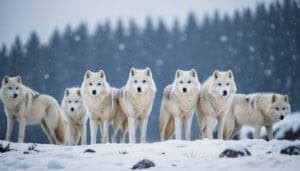Introduction
Understanding how Arctic wolves communicate within their packs is essential to comprehending their social structures and survival strategies
This article delves into the various methods of communication used by these wolves, from vocal and olfactory signals to intricate body language. We will also explore the dynamics within their packs, how pups learn to communicate, and the unique challenges posed by the harsh Arctic environment
Additionally, we will examine how these wolves coordinate their hunts and communicate during the breeding season. Finally, we will review key research findings on Arctic wolf communication
Vocal and Olfactory Communication
Arctic wolves, like other wolf species, rely heavily on both vocal and olfactory communication to maintain social bonds, coordinate activities, and establish territories. Their ability to communicate effectively in the harsh Arctic environment is crucial for their survival
Types of Vocalizations
Arctic wolves use a variety of vocalizations to convey different messages. The primary types include howls, barks, growls, and whines
Each type of vocalization serves a unique purpose:
Howls: These are perhaps the most well-known wolf vocalizations
Howling serves several functions, including long-distance communication between pack members, establishing territory, and coordinating group activities. Research has shown that howling can carry over distances of up to 10 miles in optimal conditions (Mech, 1999)
Barks: While less common, barks are typically used in situations of alarm or as a warning signal. They can alert pack members to potential threats or intruders
Growls: Growling is often a sign of aggression or dominance. It can occur during conflicts over food, during mating season, or when establishing dominance hierarchies within the pack
Whines: These vocalizations are usually associated with submissive behavior or as a form of communication between pups and adult wolves. Pups may whine to solicit care or attention from their parents
Functions of Howls and Growls
Howls and growls are particularly important for maintaining social cohesion and establishing hierarchy within the pack:
Howls: In addition to long-distance communication, howling helps to reinforce social bonds within the pack
Group howls can serve to synchronize the pack’s activities and strengthen the social structure. A study by Smith et al. (2007) found that wolves often howl together after a successful hunt or before setting out on a group activity, indicating its role in promoting group unity
Growls: Growls are more common in close-range interactions and are often used to assert dominance or to resolve conflicts
Dominant wolves may growl to keep subordinate members in line, while lower-ranking wolves may growl to challenge for higher status. This form of communication helps to minimize physical confrontations, which can be costly in terms of energy and injury
Methods of Scent Marking
Scent marking is another critical form of communication for Arctic wolves
They use scent to convey information about their identity, reproductive status, and territorial boundaries:
Urine Marking: One of the most common methods is urine marking. Wolves will urinate on objects such as rocks, trees, or the ground to leave a scent mark. These marks can provide information about the individual’s identity and reproductive status
Fecal Marking: Feces are also used for marking territory. The placement of feces at prominent locations, such as trail intersections or the edges of their range, helps to delineate the pack’s territory
Scent Glands: Wolves have scent glands on their paws, which they use to leave additional scent trails as they move through their territory. These scent trails can help to reinforce territorial boundaries and guide pack members along established paths
Information Conveyed by Scent
Scent marking conveys a wealth of information that is crucial for the pack’s social structure and territorial integrity:
Identity and Status: The scent can provide details about the individual wolf’s identity, age, sex, and social status. This information helps to maintain the pack’s hierarchy and social organization
Reproductive Status: Scent marking plays a significant role during the breeding season. Female wolves in estrus will leave specific scent marks that signal their reproductive status to potential mates. Males may respond to these signals by competing for access to the female
Territorial Boundaries: Scent marks help to establish and maintain the pack’s territory. They serve as a warning to other wolves that the area is occupied and defended. This reduces the likelihood of conflicts with neighboring packs and helps to maintain stable territories
Body Language in Arctic Wolves
Arctic wolves use a rich array of body language to communicate within their packs
This non-verbal communication includes postures, gestures, facial expressions, and tail and ear positions, all of which play a vital role in maintaining social bonds, establishing hierarchies, and coordinating pack activities
Postures and Gestures
Postures and gestures are among the most noticeable forms of body language in Arctic wolves
These visual signals help to convey dominance, submission, aggression, and other social cues:
Dominant Postures: Dominant wolves often stand tall with their heads and tails held high. Their body is stiff, and they may stare directly at subordinate wolves to assert their authority. This posture helps to reinforce the social hierarchy within the pack
Submissive Postures: Subordinate wolves display submission by lowering their bodies, tucking their tails between their legs, and avoiding direct eye contact
They may also roll over to expose their belly, signaling that they pose no threat and recognize the authority of the dominant wolf. This behavior helps to prevent conflicts and maintain pack harmony
Play Bows: Play bows are a common gesture among wolves, especially pups. A wolf will lower its front legs and chest to the ground while keeping its hindquarters raised. This posture invites other wolves to engage in play and helps to strengthen social bonds
Aggressive Postures: When a wolf is aggressive or feels threatened, it may arch its back, raise its hackles, and bare its teeth. This posture is often accompanied by growling or snarling and serves as a warning to other wolves to back off
Facial Expressions
Facial expressions are another important aspect of wolf communication
Subtle changes in facial muscles can convey a wide range of emotions and intentions:
Relaxed Expressions: A relaxed wolf will have a calm and neutral facial expression, with ears and whiskers in a natural position. This indicates that the wolf is at ease and not feeling threatened
Aggressive Expressions: An aggressive wolf will wrinkle its nose, show its teeth, and narrow its eyes. These expressions are often seen during conflicts or when the wolf is defending territory or resources
Submissive Expressions: Submissive wolves will often have a more open and soft facial expression, with their ears pulled back and eyes slightly averted. This helps to signal their lower status and avoid provoking dominant wolves
Curious Expressions: When a wolf is curious or investigating something new, it may raise its eyebrows and open its mouth slightly. This expression is often seen in pups as they explore their environment
Tail and Ear Positions
The positions of a wolf’s tail and ears are key indicators of its emotional state and social intentions:
Tail Positions
High Tail: A high tail position indicates confidence and dominance. Dominant wolves often hold their tails high when interacting with subordinate pack members
Low Tail: A low or tucked tail indicates submission, fear, or anxiety. Subordinate wolves often tuck their tails between their legs in the presence of dominant wolves
Wagging Tail: A wagging tail can indicate excitement or friendliness, especially during social interactions or play
Ear Positions
Erect Ears: Erect ears indicate alertness and attention. Wolves will perk up their ears when they are focused on a specific sound or activity
Flattened Ears: Flattened ears indicate submission, fear, or aggression. Submissive wolves will flatten their ears to signal their lower status, while aggressive wolves may do so to prepare for a potential conflict
Social Hierarchies and Pack Dynamics
Arctic wolves live in complex social structures, with each pack typically consisting of a dominant breeding pair and their offspring from various years
Understanding the social hierarchies and dynamics within these packs is crucial for comprehending their communication methods, survival strategies, and overall behavior
Alpha and Beta Roles
The alpha and beta roles are central to the social organization of an Arctic wolf pack:
Alpha Wolves: The alpha wolves are the dominant breeding pair in the pack, usually consisting of an alpha male and an alpha female
They lead the pack, make decisions regarding hunting and territory, and are the primary reproducers. The alpha pair maintains their status through displays of dominance, such as high postures, direct eye contact, and vocalizations. Their leadership is crucial for the pack’s cohesion and success
Beta Wolves: Beta wolves are the second in command and act as the right-hand wolves to the alphas
They help to maintain order within the pack and often take on leadership roles when the alphas are absent. Betas may also help in caring for and teaching the pups. While they are subordinate to the alphas, they hold significant authority over the lower-ranking members
The structure of alpha and beta roles helps to streamline decision-making processes and maintain order within the pack, ensuring that resources are effectively utilized and conflicts are minimized
Conflict and Resolution
Conflict is inevitable in any social group, and Arctic wolves have developed various methods to resolve disputes and maintain harmony:
Displays of Dominance and Submission: Most conflicts are resolved through non-violent displays of dominance and submission
Dominant wolves will assert their status through body language, such as standing tall, raising their tails, and staring down subordinate wolves. Subordinate wolves respond with submissive gestures, like lowering their bodies and avoiding eye contact, to de-escalate the situation
Vocalizations: Growls and snarls are common during conflicts and serve as warnings to other wolves. These vocalizations can help to prevent physical altercations by clearly communicating aggression or displeasure
Physical Confrontations: While rare, physical confrontations do occur, especially when the alpha status is challenged or during mating season
These fights can be intense but are usually brief, with the loser quickly submitting or retreating. Severe injuries are uncommon, as wolves tend to avoid prolonged and damaging fights
Ritualized Behavior: Some conflicts are resolved through ritualized behaviors, such as mock fights or play
These interactions allow wolves to test each other’s strength and resolve disputes without serious harm. For example, young wolves often engage in play fights to practice their skills and establish their place in the social hierarchy
Maintaining Pack Cohesion
Maintaining pack cohesion is vital for the survival and success of Arctic wolves
Several behaviors and strategies contribute to this cohesion:
Cooperative Hunting: Hunting together as a pack strengthens social bonds and ensures that all members have access to food
Wolves communicate through vocalizations and body language to coordinate their efforts during hunts, increasing their chances of success. Research by Peterson et al. (1984) shows that cooperative hunting is more efficient and effective than solo hunting, especially when targeting large prey like musk oxen or caribou
Alloparenting: Alloparenting, or the care of pups by individuals other than the parents, is common in wolf packs. Subordinate wolves, often siblings of the pups, help to feed, protect, and teach the young. This cooperative behavior enhances the survival rate of the pups and strengthens family bonds
Social Grooming: Grooming each other helps to reinforce social bonds and remove parasites. It is a common practice among pack members and plays a crucial role in maintaining group harmony. Grooming sessions often occur after hunts or during periods of rest and relaxation
Group Howling: Group howling is not only a means of communication but also a social activity that reinforces pack unity. Wolves often howl together to mark their territory, coordinate movements, or celebrate a successful hunt. This vocal behavior helps to synchronize the pack and solidify their social structure
Communication Among Arctic Wolf Pups
Communication among Arctic wolf pups is crucial for their development and integration into the pack
From birth, pups learn and practice various forms of communication, including vocalizations, body language, and play behaviors, all of which help them understand their roles within the pack and interact effectively with other members
Early Communication Development
Arctic wolf pups begin communicating almost immediately after birth, relying heavily on vocalizations and body language to express their needs and emotions:
Vocalizations: Pups use high-pitched whines and squeals to signal hunger, discomfort, or the need for attention. These vocalizations are critical for eliciting care from the adult wolves. As they grow, their vocal repertoire expands to include barks, growls, and howls, which they use to interact with siblings and adults
Body Language: Early body language includes movements like nuzzling and nudging, which help pups bond with their mother and littermates. As they become more mobile, they start to display more complex behaviors, such as tail wagging and play bows, which are essential for social interactions and play
Social Bonding: The first few weeks of a pup’s life are spent in the den, where close contact with their mother and littermates fosters strong social bonds. This period is critical for learning the basic principles of communication and social structure within the pack
Learning From Adult Wolves
Adult wolves play a significant role in teaching pups how to communicate effectively:
Imitation: Pups learn a great deal by observing and imitating adult wolves. They watch how adults use vocalizations and body language to interact with each other and gradually mimic these behaviors in their own interactions
Guidance and Correction: Adult wolves guide and correct the pups’ behavior through gentle nudges, growls, and other forms of communication. This guidance helps pups understand the appropriate contexts for different behaviors and how to respond to various social cues
Participating in Hunts: As pups grow older, they begin to participate in pack activities such as hunting
Although they start as observers, they quickly learn to follow the signals and cues of the adults, gradually becoming more active participants. This hands-on experience is crucial for developing their communication skills and understanding their roles within the pack
Social Play and Communication
Play is a vital component of pup development and serves multiple purposes, including learning communication skills, establishing social hierarchies, and practicing hunting techniques:
Play Fighting: Play fighting is one of the most common forms of social play among wolf pups
It involves chasing, wrestling, and mock biting, allowing pups to practice their physical skills and learn the nuances of body language and vocalizations. These play sessions are typically characterized by frequent play bows, which signal that the actions are not meant to be aggressive
Exploratory Play: Pups engage in exploratory play by investigating their environment and interacting with objects such as sticks, rocks, and prey remains. This type of play helps them develop problem-solving skills and understand their surroundings, while also providing opportunities to practice communication with their packmates
Social Bonds: Through play, pups form strong social bonds with their siblings and other pack members. These bonds are reinforced by positive interactions and shared experiences, laying the foundation for cooperative behaviors and pack cohesion in adulthood
Hierarchy Establishment: Play also serves as a means for establishing and reinforcing social hierarchies among the pups. Through their interactions, they learn their place in the pack’s social structure and how to navigate relationships with dominant and subordinate individuals
Coordinating Hunts Through Communication
Hunting is a critical activity for Arctic wolves, and successful hunts require effective communication and coordination within the pack
Arctic wolves utilize a variety of vocalizations, body language, and behavioral cues to organize and execute hunts, ensuring that they can efficiently capture prey in the harsh Arctic environment
Pre-Hunt Signals
Before a hunt begins, Arctic wolves use several pre-hunt signals to prepare and coordinate the pack:
Vocalizations: Howling is a common pre-hunt vocalization. It serves to gather the pack members and synchronize their movements
According to a study by Mech (1999), group howling before a hunt helps to boost the morale and cohesiveness of the pack, ensuring that all members are ready and aware of the upcoming activity
Physical Cues: Wolves also use body language to signal the start of a hunt. Dominant wolves, often the alphas, will initiate the hunt by adopting a focused and alert posture. They may also perform specific gestures, such as a play bow, to signal the readiness to begin
Movement Coordination: The pack often moves together in a coordinated manner before the hunt, with the dominant wolves leading the way. This movement helps to align the pack’s efforts and ensures that all members are on the same page regarding the hunt’s strategy
Communication During the Hunt
During the hunt, Arctic wolves rely on a combination of vocal and visual signals to maintain coordination and adapt to changing circumstances:
Barking and Yipping: Short barks and yips are used to communicate immediate information, such as the direction of the prey or changes in the hunting strategy. These vocalizations are crucial for maintaining cohesion and ensuring that the pack can respond quickly to the movements of the prey
Body Language: Wolves use body language extensively during hunts. For instance, a wolf may crouch low to signal that it has spotted the prey or adopt a stalking posture to indicate a coordinated attack. Tail positions are also significant; a raised tail can signal excitement and readiness, while a lowered tail may indicate caution
Chase Coordination: As the pack chases its prey, wolves will often break into smaller sub-groups to encircle and corner the target
This division of labor is facilitated by constant visual and vocal communication, allowing the pack to adapt dynamically to the prey’s movements. A study by Peterson et al. (1984) found that this level of coordination significantly increases the success rate of hunts, particularly when targeting large and mobile prey like caribou
Post-Hunt Interactions
After the hunt, Arctic wolves engage in various interactions that serve to reinforce social bonds and distribute the spoils of their efforts:
Group Howling: Successful hunts are often followed by group howling sessions
This behavior serves multiple purposes, including celebrating the success of the hunt, reinforcing social bonds, and communicating the pack’s presence to other wolves in the area. It helps to maintain pack cohesion and morale, ensuring that the group remains unified
Food Sharing: The alpha wolves typically eat first, followed by the betas and other subordinate wolves
This hierarchical feeding order reinforces the social structure of the pack. However, it is also common for food to be shared among all members, including the pups and lower-ranking individuals. This sharing is crucial for the survival of the entire pack, particularly in the resource-scarce Arctic environment
Social Grooming: Post-hunt grooming sessions help to clean the wolves and remove any parasites picked up during the hunt. This grooming also serves as a bonding activity, reinforcing the social ties within the pack. Wolves will lick and nibble each other’s fur, promoting group cohesion and reducing stress
Impact of the Arctic Environment on Communication
The Arctic environment presents unique challenges that influence the communication strategies of Arctic wolves. Extreme cold, vast open spaces, and seasonal variations require adaptations in how these wolves convey information and maintain social cohesion
Challenges Posed by the Arctic Climate
The harsh Arctic climate significantly impacts the communication methods of Arctic wolves:
Extreme Cold: Temperatures in the Arctic can drop well below freezing, which affects both vocal and non-vocal communication. Vocalizations need to be efficient and effective despite the cold, which can alter sound propagation. Wolves may rely more on short, loud barks and howls that carry well in the cold air
Vast Open Spaces: The expansive, open terrain of the Arctic tundra means that wolves often need to communicate over long distances
Howling is particularly important in this context, as it can travel up to 10 miles in favorable conditions (Mech, 1999). This allows pack members to stay in contact even when they are far apart
Limited Vegetation: The scarcity of trees and other vegetation in the Arctic means that wolves have fewer natural barriers to help contain scent marks. This necessitates frequent and strategic scent marking to maintain territorial boundaries and communicate effectively through olfactory signals
Adaptations in Communication
Arctic wolves have developed specific adaptations to overcome the challenges posed by their environment:
Enhanced Vocalizations: Arctic wolves have a rich repertoire of vocalizations tailored to their environment
Howling is adapted to carry long distances, and wolves often use higher-pitched tones that travel better in cold air. They also use a variety of vocal signals to convey different messages, from long-range communication to close-range interactions
Strategic Scent Marking: Given the vast and open landscape, Arctic wolves mark their territory with urine and feces at strategic locations, such as trail intersections and prominent landmarks
They also use their scent glands to leave marks as they travel. This helps to establish clear territorial boundaries and communicate their presence to other packs
Coordinated Movements: To cope with the expansive terrain, Arctic wolves often move in coordinated groups, using body language and vocal signals to maintain cohesion
This coordination is crucial during hunts and when navigating their territory, ensuring that all pack members stay together and communicate effectively
Seasonal Variations
The extreme seasonal changes in the Arctic have a profound impact on wolf communication:
Winter: During the long Arctic winter, wolves rely heavily on howling to communicate across the snowy, open landscape
The cold air can enhance the travel of sound, making vocal communication particularly effective. Wolves also use body language more prominently, as visual signals can be more easily seen against the stark white backdrop of snow
Summer: In the brief Arctic summer, the melting snow and increased vegetation can affect scent marking
Wolves may need to remark their territory more frequently as scents dissipate faster in the warmer weather. The increased daylight hours also mean that visual signals, such as body postures and tail positions, become more significant in communication
Breeding Season: During the breeding season, communication becomes even more critical
Vocalizations and scent marking are used extensively to attract mates and establish dominance. Female wolves in estrus will leave specific scent marks to signal their reproductive status, while males may increase their vocal activity to deter rivals and attract females
Communication During Breeding Season
The breeding season is a critical period for Arctic wolves, and effective communication is essential for successful mating and rearing of offspring
During this time, wolves use a combination of vocal, olfactory, and physical signals to find mates, establish pair bonds, and care for their pups
Courtship Behaviors
Courtship behaviors in Arctic wolves involve a complex interplay of vocalizations, body language, and scent marking:
Vocalizations: During the breeding season, wolves increase their vocal activity
Males may howl more frequently and with greater intensity to signal their presence to potential mates and deter rivals. Female wolves may also vocalize to communicate their availability and readiness to mate. These vocalizations help to establish contact between males and females over long distances
Scent Marking: Scent marking becomes more frequent and targeted during the breeding season
Female wolves in estrus produce distinctive pheromones that indicate their reproductive status. Males can detect these scents from great distances and will follow the trails left by females. Males also increase their scent marking to assert dominance and advertise their presence to females
Physical Displays: Courtship involves a range of physical displays, such as play bows, gentle nudging, and mutual grooming
These behaviors help to strengthen the bond between the male and female and ensure mutual interest. Dominant postures and movements are also common as males compete for the attention of females and establish their suitability as mates
Vocal and Physical Signals
Vocal and physical signals are crucial for communication during the breeding season:
Howls and Whines: Howling is used extensively to maintain contact between mates and synchronize their activities
Whines and other vocalizations are common during courtship and mating, helping to reinforce the bond between the pair. These sounds convey emotions and intentions, ensuring clear communication between partners
Body Language: Wolves use body language to communicate readiness to mate and establish pair bonds
Subtle cues such as tail positions, ear movements, and eye contact play a significant role. For example, a female wolf may lower her body and wag her tail to signal receptiveness, while a male may approach with a relaxed and submissive posture to gain her trust
Mating Rituals: Mating rituals often involve a series of coordinated behaviors, including circling, nudging, and licking
These rituals help to ensure that both wolves are synchronized and comfortable, facilitating successful copulation. The rituals also reinforce the social bond between the pair, which is crucial for cooperative parenting
Raising Pups
Once mating is successful, the focus shifts to raising the pups. Communication between the parents and with the rest of the pack is vital during this stage:
Den Selection: The female wolf will select a suitable den site where she can give birth and raise the pups. Communication between the male and female is crucial in choosing a safe and secure location. The pair will use vocalizations and body language to coordinate their efforts in preparing the den
Parental Care: Both parents play active roles in caring for the pups
The mother provides constant care and protection, while the father hunts and brings back food. Vocalizations such as whines and growls are used to communicate between the parents and ensure that the pups’ needs are met. The mother may whine to call the male back to the den or growl to warn of potential threats
Pack Involvement: The entire pack is involved in raising the pups, a behavior known as alloparenting
Subordinate wolves help with feeding, grooming, and protecting the young. This cooperative behavior is communicated through various signals, including vocalizations and body language. For example, pups may whine or yip to solicit attention and care from other pack members
Learning and Socialization: As the pups grow, they learn essential survival skills through observation and play
Adult wolves communicate with the pups using a combination of vocal signals, body language, and physical interaction. Play fighting, chasing, and mock hunting help the pups develop their motor skills and understand social hierarchies. The parents and other pack members provide guidance and correction through gentle nudges, growls, and other signals
Research on Arctic Wolf Communication
Understanding the communication methods of Arctic wolves requires comprehensive research conducted through field studies, observations, and various scientific methodologies
Researchers have been studying these wolves for decades, uncovering fascinating insights into their complex social behaviors and communication strategies
Key Studies and Findings
Numerous studies have shed light on the intricate communication systems of Arctic wolves:
Vocal Communication: A seminal study by Mech (1999) highlighted the importance of howling in maintaining pack cohesion and facilitating long-distance communication. This research demonstrated that howling serves multiple functions, from territory marking to rallying the pack for hunts
Scent Marking: Research by Peterson et al. (1984) focused on the role of scent marking in territorial behavior. The study found that Arctic wolves strategically use urine and feces to demarcate their territory, which helps to prevent conflicts with neighboring packs and ensures access to critical resources
Social Hierarchies: A study by Smith et al. (2007) examined the social hierarchies within Arctic wolf packs, revealing the intricate dynamics between alpha, beta, and subordinate wolves. This research showed how communication through body language and vocalizations helps to establish and maintain these hierarchies
Pup Development: Research on pup development and communication, such as the work by Packard and Mech (2001), provided insights into how young wolves learn to communicate through play and interactions with adults. The study emphasized the role of social learning in developing effective communication skills
Methods of Study
Researchers use a variety of methods to study Arctic wolf communication, often combining field observations with advanced technologies:
Field Observations: Direct observation of wolf behavior in their natural habitat is a primary method for studying communication
Researchers spend extended periods in the field, documenting vocalizations, body language, and interactions within the pack. This method provides valuable qualitative data on wolf behavior and social structures
Radio Collar Tracking: Radio collars equipped with GPS tracking devices are used to monitor the movements and interactions of individual wolves. This technology allows researchers to gather data on how wolves communicate and coordinate over large distances, particularly during hunts and territory patrols
Acoustic Monitoring: Acoustic monitoring involves recording and analyzing wolf vocalizations
Researchers use specialized equipment to capture howls, barks, and other vocalizations, which are then analyzed to understand their functions and meanings. This method helps to quantify vocal communication and identify patterns
Scent Analysis: To study olfactory communication, researchers collect and analyze scent marks, such as urine and feces
Chemical analysis of these samples can reveal information about the individual wolf’s identity, reproductive status, and health. This method provides insights into the chemical signals used in wolf communication
Behavioral Experiments: Controlled experiments, often conducted in captivity or semi-wild environments, allow researchers to manipulate variables and observe their effects on wolf behavior. These experiments can test specific hypotheses about communication and social interactions
Future Directions
Continued research on Arctic wolf communication is essential for advancing our understanding of these remarkable animals and their adaptation to the Arctic environment
Future research directions include:
Impact of Climate Change: Studying how climate change affects Arctic wolf communication and behavior is a critical area of research. As the Arctic environment undergoes significant changes, understanding how wolves adapt their communication strategies will be crucial for their conservation
Genetic Studies: Investigating the genetic basis of communication behaviors can provide insights into the evolution of sociality and communication in wolves. Genetic studies can help identify the heritable traits that influence vocalizations, scent marking, and social interactions
Inter-Pack Communication: Exploring how different wolf packs communicate with each other can reveal broader social dynamics and territorial interactions. This research can help to understand the larger ecological and social networks of Arctic wolf populations
Technological Advances: Utilizing emerging technologies, such as drones and advanced acoustic sensors, can enhance data collection and analysis. These technologies can provide new perspectives on wolf communication and behavior, enabling more precise and comprehensive studies
Conservation Applications: Applying research findings to conservation efforts is a vital goal. Understanding wolf communication can inform strategies for managing wolf populations, mitigating human-wolf conflicts, and preserving critical habitats
Conclusion
Understanding how Arctic wolves communicate within their packs is fundamental to comprehending their social structures and survival strategies
This article explored various aspects of Arctic wolf communication, highlighting the sophisticated methods these animals use to interact and thrive in the harsh Arctic environment
First, we examined the vocal and olfactory communication methods, including the types and functions of vocalizations like howls, growls, and whines, as well as the strategic use of scent marking. Next, we delved into the body language of Arctic wolves, covering postures, gestures, facial expressions, and the significance of tail and ear positions
We then discussed the importance of social hierarchies and pack dynamics, detailing the roles of alpha and beta wolves, conflict resolution strategies, and methods for maintaining pack cohesion. The section on communication among Arctic wolf pups highlighted the critical early development stages and the role of adults in teaching and guiding the young
Furthermore, we explored how Arctic wolves coordinate hunts through communication, focusing on pre-hunt signals, communication during the hunt, and post-hunt interactions. The impact of the Arctic environment on communication was another key area, illustrating how wolves adapt their strategies to the challenges posed by extreme cold, vast open spaces, and seasonal variations
Communication during the breeding season was also covered, emphasizing courtship behaviors, vocal and physical signals, and the cooperative efforts involved in raising pups. Lastly, we reviewed significant research on Arctic wolf communication, discussing key studies, methods of study, and future research directions
Overall, the intricate communication systems of Arctic wolves are essential for their social structure, hunting efficiency, and survival in one of the world’s most challenging habitats. Continued research and understanding of these communication methods are vital for the conservation and protection of Arctic wolf populations










